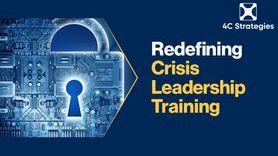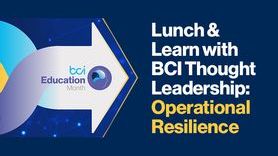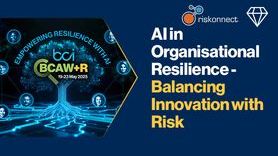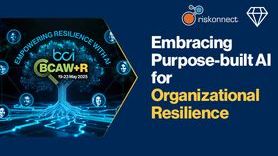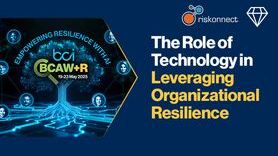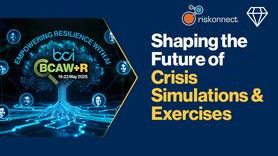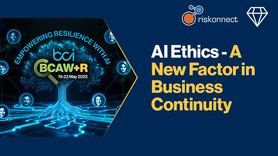The Human Element - How to Build Organizational Resilience Through Employee Engagement
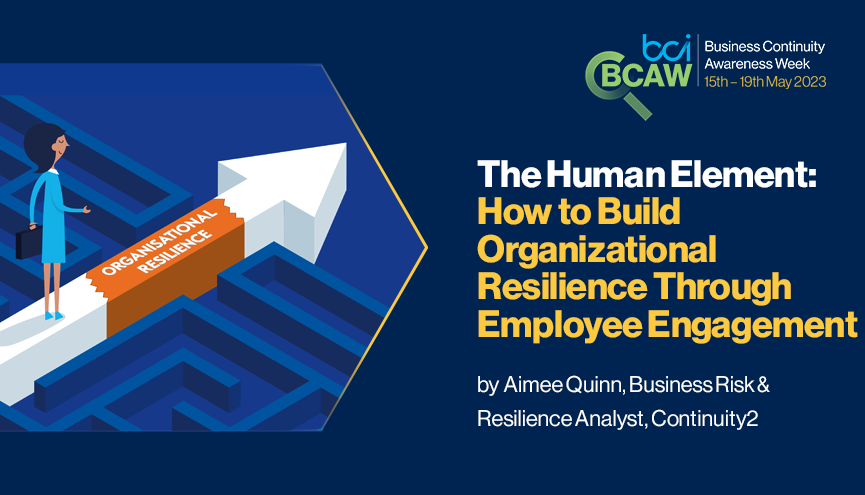
From system failures and data breaches to human errors and natural disasters, operational disruptions aren’t something anyone expects to happen, and no one can guarantee against them. What matters most is how employees weather challenges and setbacks, which can be part of the organization’s framework to ensure business continuity and thrive in the face of adversity.
Organizational resilience does not happen by chance. It requires more than just the leaders being resilient during tough times. When you say that you have a resilient organization, it involves everyone within the company.
What is employee engagement?
Employee engagement and organizational resilience are closely tied to each other. There are many resources available on how to build resilient organizations, but you simply have to return to the basics – promoting employee engagement.
To understand that, let’s first define employee engagement. Employee engagement refers to employees’ mental and emotional connection with their work or the organization. The higher the employee’s engagement level, the more committed and motivated they are to perform their job. A highly engaged employee advocates for the organization and is in it for the long term. Meanwhile, disengaged employees aren’t committed to giving their best work and are more likely to move to another organization if a better opportunity arises.
For business leaders, it’s important to listen to your employees. Encourage employees to speak up about their fears and concerns. Let them share their thoughts on particular issues that directly affect them or the organization. There are obvious benefits for the business leadership to focus on employee engagement, such as improved employee retention and higher productivity.
However, employee engagement is far more complex than that. Recently, it is emerging as one of the top drivers of high-reliability and resilient organizations. Business leaders are finally starting to realise the connection between engaged employees and the level of organizational resilience. If you want to develop the capabilities of a resilient organization, you need to promote higher employee engagement. It starts with your organizational routines which empower employees and encourages them to have a voice.
Research shows that resilient employees perform better and are more effective. Hence, you can get a double benefit when you start promoting employee engagement, which creates more success in your goal of developing resilience within your organization.
How to engage employees in business continuity planning
Your employees play a vital role in developing a resilient organization. While it’s true that employees should defer to those with designated roles during an incident, having a good awareness of the company’s business continuity plan can make the response and recovery processes go more smoothly. Engaging employees in business continuity planning is how resilient organizations succeed. So, how do you improve your planning and identify gaps in your existing organizational resilience plans with the help of your employees?
Here are some of the ways that you can get them involved:
1. Make sound decisions based on employees’ input
The first step to building organizational resilience and making employees the driver of your business continuity plan is transparency. The days of senior leaders and management making all the decisions impacting the entire organization are long gone. Now, you need to implement transparency in how you build strategies that enable your organization to build resilience during times of disruptions.
Not all employees will have a direct role in BC planning. Still, they should play an active role in providing accurate data and feedback as part of their involvement in business impact analysis (BIAs) and BC exercises, which can help the business continuity team reach more effective decisions.
2. Test and exercise the plan
Testing is where employees will play the most critical role in your business continuity strategies. Your plans are only as effective as your employees’ ability to execute them. Therefore, testing your business continuity strategies and plans regularly is important. It will inform you of any appropriate changes you need to make to ensure those plans are effective.
Your BC team should schedule regular testing of your BCP strategies quarterly or annually, depending on your goals and risk level. Regular testing ensures that the plans remain fresh in your participants’ memories and that those with BC roles and responsibilities have the awareness and knowledge suited for their designated roles. It’s also a good time to evaluate if your communication plans are updated and if there are any gaps you could improve on.
3. Drive communication with your team
As mentioned earlier, communication plays a critical role in engaging your employees in your business continuity strategies and in how resilient organizations thrive. The hierarchy and leadership in your business shouldn’t be an obstacle in how you communicate during times of disruption or when a disruptive event occurs.
Make sure you drive strategies which improve your communication. It’s also crucial that employees can push information “up the field” if they identify potential risks or when developing solutions for specific risks or issues.
Involving all employees in communicating about disruption, not just those in leadership positions, can offer the benefit of pushing messages more rapidly. It also empowers your employees to gather and report vital information when an incident occurs. The consistent and accessible flow of information enables your team to make informed decisions faster and helps boost your organizational resilience over time.
4. Leverage your employees’ skills
Another way that you can build organizational resilience is by utilising your employees’ skills. Designate roles for your team members according to their skill level or knowledge. It allows them to be more effective in their roles since they can take specific actions aligned with their skill set.
However, as noted above, not everyone will have a designated role during a disruption, which can be varied in scenario, scope, and many other factors.
If your employees don’t have pertinent skills or knowledge that would be crucial during a time of disruption, this is where education and training come in. Take this opportunity to equip them with the capabilities needed to respond and adapt if a disruptive event occurs.
5. Encourage transparency in employee reporting
Your employees are the ones who are in the facility or the workspace dealing with the daily operations, so they are often the first ones to notice the issues that can potentially disrupt the business. Those in charge of BC must communicate clearly and effectively so your employees are aware of how to take initial steps to handle and cope with incidents.
Encourage your employees to report any inconsistencies with the operations so that you can identify potential threats as a business unit. The sooner those issues are reported, the sooner they can be addressed. It is a crucial step in ensuring that these issues won’t happen again and can be remedied before they can negatively impact the entire organization.
Creating a culture of resilience
The best way to achieve organizational resilience is through employee engagement. But how do you get the same level of commitment from your employees as a dedicated BC team when it comes to maintaining resilience during times of uncertainty? One way to do that is to integrate resilience as part of the company and work culture.
When you build resilience from within, your employees feel empowered because they know they can respond and adapt to any situations thrown their way. It also makes them feel valued because the leadership management trusts them to perform their role and respond quickly when challenges arise, no matter the seriousness of the circumstances.
To prepare for uncertainty in your business, you can foster a culture of resilience. Here are some of the strategies you can implement:
1. Train and raise awareness of business continuity within organizations
You can build a culture of resilience in your organization by equipping your employees with proper training and awareness. The training enables them to acknowledge and report unusual or disruptive situations to the right people. In this way, the organization can respond to and recover from any sudden disruptions quickly.
Training also makes employees feel empowered, especially if they have access to the resources and tools they need, as well as workarounds where possible, to maintain business operations. The training is not just a one-time thing. As you will find out later, you must strive for continuous improvement to help your employees adapt their skills to the changing challenges you face as an organization.
2. Make sure your employees understand your plan
Keep your employees informed about your organization’s overarching mission. Understanding that mission and being able to contribute towards that gives them a deeper sense of purpose in their roles. Having that shared sense of purpose empowers your employees and makes the work they do feel valued.
Tie that into your organizational resilience strategies so they can use that drive to make an impact on the entire organization. Use it as fuel to enrich your existing strategies so that everyone in your team is prepared to handle any circumstances.
3. Keep communication lines open
Good communication is one of the most important elements of any organization’s ability to respond and adapt to sudden disruptions. During a disruptive event, communication is of paramount importance. Therefore, building a culture of organizational resilience begins with good communication strategies.
Spreading awareness of communication channels/methods during exercising and training can help employee awareness of how they can expect to be communicated with during an incident. It is important to clearly identify in your communications when it is a live incident and not a test. If an incident occurs, clear and instant communication from your BC team is paramount for the rest of your staff in order to know what is expected of them and continue to perform their duties.
4. Acknowledge issues and address them
Another step to building a resilient organization and developing a resilient work culture is to recognise issues within the organization as they arise. Many businesses and organizations fail because they sweep problems under the rug. As a result, the same issues arise over and over again.
The best way to overcome this is to acknowledge that problems do exist. If your employees have to deal with similar issues repeatedly, it can negatively impact their morale. But when you address issues upfront, you have the opportunity to solve problems right from the get-go and put those issues behind you.
At the same time, you can develop capabilities that are vital to building organizational resilience. For instance, you can identify processes that will resolve the existing issues to prevent them from occurring again.
5. Give them the right tools to help them succeed
While the term “resilience” does carry individuals’ emotional ability, a resilient organization, in fact, requires a systematic approach to preparing for and responding to unexpected events or disruptions. Without the right tools, it’s only a matter of time before employees start to feel disengaged, which leads to decreased productivity, poor performance, and eventually a significant negative impact on the organization’s bottom line.
Another thing to consider is employees’ readiness and willingness for the culture of resilience, as they are the building blocks of any resilient organization. The goal of implementing new tools should be making everyone’s life easier, not doubling their work. Hence, it’s important to provide not only the right but also easy-to-use tools to build organizational resilience .
6. Provide feedback and support
Building a culture of resilience in your organization is an ongoing process. Therefore, providing training and education is not the only solution. You have to continuously offer guidance and support to the team, giving feedback where and when necessary. It’s a crucial step to ensure ongoing improvement to your processes and the capabilities of every individual.
When employees feel they have the right support, they develop solutions as a team that can move forward as one unit.
The importance of continuous improvement
Resilience is like a skill. It’s something you foster and develop over time, not something you’re born with. Look at this as an opportunity to make your employees more resilient and confident to face potential problems in your organization.
For this, you must provide opportunities for growth and learning. Prepare your employees for uncertainty in your business by promoting knowledge-sharing practices, and build their confidence by supporting that with awareness training.
Having a feedback mechanism in place also helps ensure they can seek ways to improve their knowledge and increase their resilience level. And make sure you have tools to support your quest to achieve organizational resilience.
Conclusion
Your employees are most critical to achieving organizational resilience. While most organizations focus on the process and strategies, which are extremely important, you shouldn’t lose sight of the drivers for all these processes, resources, and strategies – the people or, simply put, your employees.
Without employees’ knowledge, skill, and training, you won’t be able to execute and implement these strategies when a disruption occurs. You won’t get the complete picture of how to build resilience if you don’t factor in the human element or the people who will be directly responding to the sudden disruptions in your business.
Organizational resilience is critical to your survival as a business during uncertainty. But building individual resilience is just as critical among your frontline workers.
Get involved in BCAW 2023 - click here






